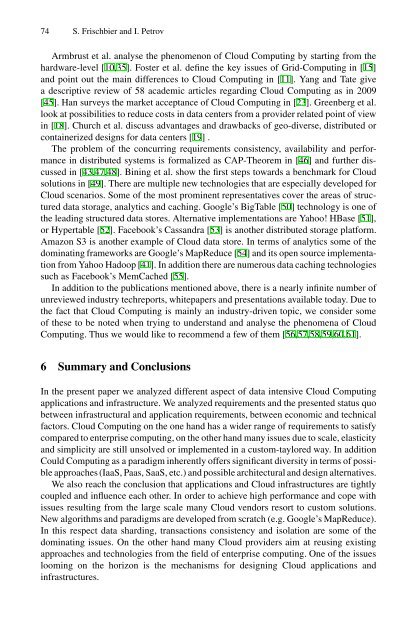Aspects of Data-Intensive Cloud Computing - DVS - Technische ...
Aspects of Data-Intensive Cloud Computing - DVS - Technische ...
Aspects of Data-Intensive Cloud Computing - DVS - Technische ...
You also want an ePaper? Increase the reach of your titles
YUMPU automatically turns print PDFs into web optimized ePapers that Google loves.
74 S. Frischbier and I. Petrov<br />
Armbrust et al. analyse the phenomenon <strong>of</strong> <strong>Cloud</strong> <strong>Computing</strong> by starting from the<br />
hardware-level [10,35]. Foster et al. define the key issues <strong>of</strong> Grid-<strong>Computing</strong> in [15]<br />
and point out the main differences to <strong>Cloud</strong> <strong>Computing</strong> in [11]. Yang and Tate give<br />
a descriptive review <strong>of</strong> 58 academic articles regarding <strong>Cloud</strong> <strong>Computing</strong> as in 2009<br />
[45]. Han surveys the market acceptance <strong>of</strong> <strong>Cloud</strong> <strong>Computing</strong> in [23]. Greenberg et al.<br />
look at possibilities to reduce costs in data centers from a provider related point <strong>of</strong> view<br />
in [18]. Church et al. discuss advantages and drawbacks <strong>of</strong> geo-diverse, distributed or<br />
containerized designs for data centers [19] .<br />
The problem <strong>of</strong> the concurring requirements consistency, availability and performance<br />
in distributed systems is formalized as CAP-Theorem in [46] and further discussed<br />
in [43,47,48]. Bining et al. show the first steps towards a benchmark for <strong>Cloud</strong><br />
solutions in [49]. There are multiple new technologies that are especially developed for<br />
<strong>Cloud</strong> scenarios. Some <strong>of</strong> the most prominent representatives cover the areas <strong>of</strong> structured<br />
data storage, analytics and caching. Google’s BigTable [50] technology is one <strong>of</strong><br />
the leading structured data stores. Alternative implementations are Yahoo! HBase [51],<br />
or Hypertable [52]. Facebook’s Cassandra [53] is another distributed storage platform.<br />
Amazon S3 is another example <strong>of</strong> <strong>Cloud</strong> data store. In terms <strong>of</strong> analytics some <strong>of</strong> the<br />
dominating frameworks are Google’s MapReduce [54] and its open source implementation<br />
from Yahoo Hadoop [41]. In addition there are numerous data caching technologies<br />
such as Facebook’s MemCached [55].<br />
In addition to the publications mentioned above, there is a nearly infinite number <strong>of</strong><br />
unreviewed industry techreports, whitepapers and presentations available today. Due to<br />
the fact that <strong>Cloud</strong> <strong>Computing</strong> is mainly an industry-driven topic, we consider some<br />
<strong>of</strong> these to be noted when trying to understand and analyse the phenomena <strong>of</strong> <strong>Cloud</strong><br />
<strong>Computing</strong>. Thus we would like to recommend a few <strong>of</strong> them [56,57,58,59,60,61].<br />
6 Summary and Conclusions<br />
In the present paper we analyzed different aspect <strong>of</strong> data intensive <strong>Cloud</strong> <strong>Computing</strong><br />
applications and infrastructure. We analyzed requirements and the presented status quo<br />
between infrastructural and application requirements, between economic and technical<br />
factors. <strong>Cloud</strong> <strong>Computing</strong> on the one hand has a wider range <strong>of</strong> requirements to satisfy<br />
compared to enterprise computing, on the other hand many issues due to scale, elasticity<br />
and simplicity are still unsolved or implemented in a custom-taylored way. In addition<br />
Could <strong>Computing</strong> as a paradigm inherently <strong>of</strong>fers significant diversity in terms <strong>of</strong> possible<br />
approaches (IaaS, Paas, SaaS, etc.) and possible architectural and design alternatives.<br />
We also reach the conclusion that applications and <strong>Cloud</strong> infrastructures are tightly<br />
coupled and influence each other. In order to achieve high performance and cope with<br />
issues resulting from the large scale many <strong>Cloud</strong> vendors resort to custom solutions.<br />
New algorithms and paradigms are developed from scratch (e.g. Google’s MapReduce).<br />
In this respect data sharding, transactions consistency and isolation are some <strong>of</strong> the<br />
dominating issues. On the other hand many <strong>Cloud</strong> providers aim at reusing existing<br />
approaches and technologies from the field <strong>of</strong> enterprise computing. One <strong>of</strong> the issues<br />
looming on the horizon is the mechanisms for designing <strong>Cloud</strong> applications and<br />
infrastructures.















